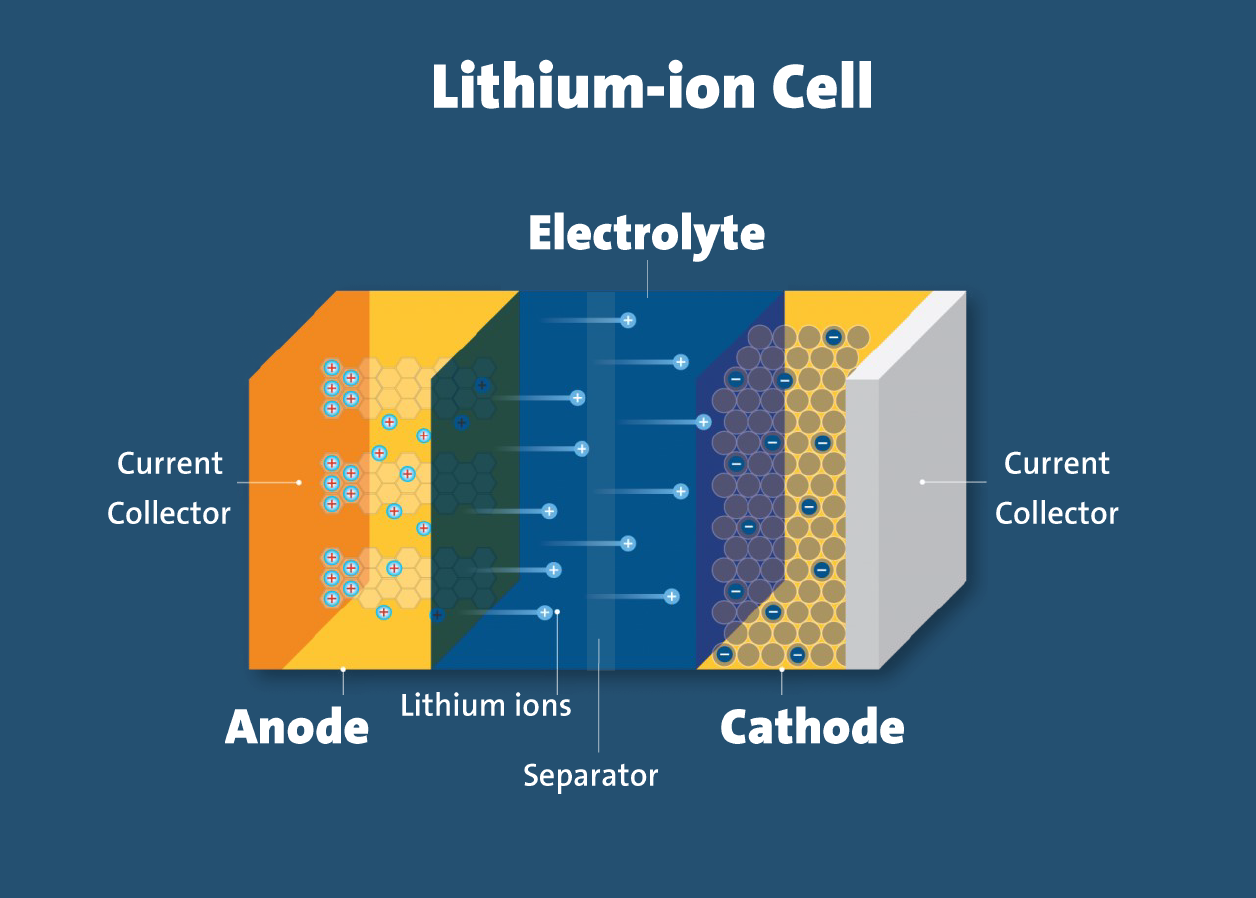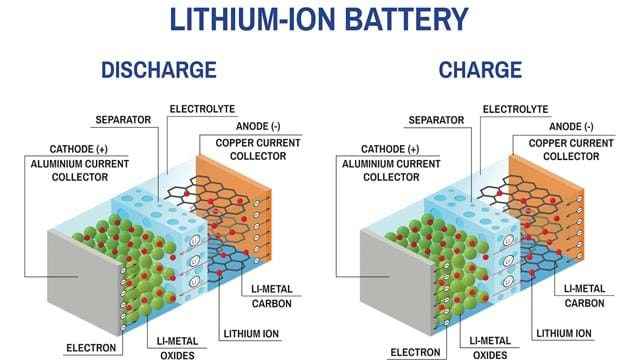Have you heard of the debate about the right type of battery to power our solar street lights efficiently? If not, consider this your introduction to an enlightening conversation. Amidst the discussions, the LiFePO4 (Lithium Iron Phosphate) battery has emerged as a compelling contender. This raises a crucial question: Is the LiFePO4 battery truly suitable for solar street lights? Let’s dive in and discover the characteristics that make LiFePO4 stand out, assessing its viability and potential advantages in the realm of solar-powered street lighting systems.

What is a LiFePO4 battery?
A lithium iron phosphate battery, is a type of rechargeable lithium-ion battery that utilizes lithium iron phosphate (LiFePO4) as the cathode material. This type of battery is known for its high energy density, long cycle life, and improved safety compared to other lithium-ion battery chemistries.
The process and components in the LiFePO4 battery
i. Cathode Material (LiFePO4):
- The cathode is the positive electrode in the battery.
- LiFePO4 is a lithium iron phosphate compound that is used as the cathode material in LiFePO4 batteries. It is known for its stability and safety characteristics.
ii. Anode Material
- The anode is the negative electrode in the battery.
- Graphite is commonly used as the anode material in LiFePO4 batteries. During discharging, lithium ions move from the anode to the cathode through an electrolyte.
iii. Electrolyte:
- The electrolyte is a substance that facilitates the movement of ions between the cathode and the anode.
- LiFePO4 batteries typically use a lithium-ion conducting electrolyte, which allows lithium ions to move back and forth during charging and discharging.
iv. Separator:
- The separator is a permeable membrane that physically separates the cathode and anode while allowing the flow of ions between them.
- It prevents short circuits by preventing direct contact between the cathode and anode.
v. Ion Movement (Charge and Discharge):
- During charging, lithium ions move from the graphite anode to the LiFePO4 cathode. This is an endothermic process.
- During discharging (when the battery is providing power), the lithium ions move from the cathode back to the anode, releasing energy in an exothermic process.
vi. Voltage and Capacity:
- The voltage of a LiFePO4 cell is typically around 3.2 to 3.3 volts.
- The capacity of a battery is determined by the amount of lithium ions that can be stored in the cathode and anode materials.
vii. Cycle Life:
- LiFePO4 batteries are known for their long cycle life, meaning they can undergo a large number of charge and discharge cycles before experiencing significant degradation.
Components of a LiFePO4 battery
Why is a LiFePO4 battery suitable?
This LiFePO4 battery has gained popularity due to its unique features and advantages over other battery chemistries. What are some of these benefits?
i. High energy density
In the LiFePO4 battery, lithium ions move between the positive electrode (cathode) composed of iron phosphate and the negative electrode (anode) during both charging and discharging processes. This dynamic ion movement enables the battery to achieve a remarkable energy density, denoting the amount of energy stored per unit volume or weight.
The unique crystal structure of iron phosphate in the cathode plays a pivotal role in enhancing energy density. The rigid lattice structure of LiFePO4 not only facilitates the efficient movement of lithium ions but also minimizes the risk of structural degradation during repeated charge-discharge cycles. This structural stability contributes significantly to the longevity and sustained high performance of LiFePO4 batteries.
Moreover, the high voltage platform of LiFePO4 chemistry, typically around 3.3 volts, further amplifies its energy density compared to other lithium-ion chemistries. This elevated voltage range allows a LiFePO4 battery to deliver more energy per unit mass, making them a preferred choice for applications where a compact and lightweight power source with extended operational cycles is essential.
ii. Long cycle life
A liFePO4 battery boasts an inherently prolonged cycle life, a consequence of the robust structural stability and enhanced resilience of the lithium iron phosphate cathode material. This superior electrochemical stability minimizes the occurrence of undesirable side reactions and electrode degradation. Moreover, the crystal structure of the cathode material inherently mitigates issues such as particle cracking and electrolyte decomposition. The unique olivine crystal lattice of LiFePO4 provides a stable framework for lithium-ion intercalation and deintercalation during charge and discharge cycles, preventing the material from undergoing structural deterioration over time.
The solid-state nature of LiFePO4 electrodes reduces the likelihood of electrode-electrolyte interactions that can lead to capacity fade and performance degradation. This intrinsic stability results in a battery system that maintains high energy efficiency and retains its electrochemical integrity over a significantly greater number of cycles compared to traditional lithium-ion chemistries.
iii. Enhanced safety features
One of the prominent advantages lies in their robust thermal stability, attributed to the inherent properties of lithium iron phosphate. This compound exhibits a high tolerance to elevated temperatures, mitigating the risk of thermal runaway reactions that may lead to catastrophic failures in other battery chemistries.
The active involvement of a LiFePO4 battery in minimizing the dendrite formation phenomenon contributes significantly to their safety profile. Dendrites, which are undesirable lithium metal projections, can trigger short circuits within the battery cell. LiFePO4’s structural stability and inherent resistance to dendrite formation substantially reduce the risk of internal short circuits, ensuring a heightened level of safety during operation.
Moreover, the incorporation of advanced battery management systems (BMS) further amplifies the safety prowess of LiFePO4 batteries. These systems actively monitor and regulate various parameters, such as voltage, temperature, and state of charge, optimizing the battery’s performance while concurrently preventing potential safety risks.
iv. Wide operating temperature range
This innovative battery exhibits remarkable thermodynamic characteristics chemistry. It has unparalleled resilience across a spectrum of temperatures, ranging from sub-zero extremes to elevated heat levels. At lower temperatures, the LiFePO4 battery demonstrates heightened ionic conductivity and reduced internal resistance, ensuring efficient charge and discharge processes even in frigid environments. This is attributed to the superior crystalline structure of the lithium iron phosphate cathode, which facilitates swift ion diffusion and electron transfer, maintaining optimal electrochemical performance.
Conversely, under elevated temperatures, the LiFePO4 battery showcases exceptional thermal stability and mitigates the risk of thermal runaway, a phenomenon associated with some other lithium-ion chemistries. This resilience is a consequence of the robust chemical bonds within the LiFePO4 structure, preventing decomposition and enhancing the overall safety profile.
v. Minimal environmental impact
Unlike traditional battery technologies that rely on materials with significant ecological footprints, LiFePO4 batteries are characterized by their inherently eco-friendly composition. The cathode of a LiFePO4 battery is composed of lithium iron phosphate, a compound renowned for its environmental benignity. This particular chemical structure not only ensures high-performance energy storage but also diminishes the adverse ecological consequences associated with battery production and disposal.
Furthermore, the life cycle of LiFePO4 batteries is marked by an extended operational span, leading to reduced overall resource consumption and a diminished need for frequent replacements. This longevity attribute contributes significantly to a more sustainable energy landscape, aligning with the principles of circular economy and resource efficiency.
Challenges of a lifepo4 battery in solar street lights
While LiFePO4 batteries offer numerous advantages, their application in solar street lights is not without challenges. Understanding and addressing these challenges is crucial for optimizing the performance of your solar street light. What are some of these challenges?
- Cost Considerations: While the cost of LiFePO4 batteries has decreased over time, it may still be higher than other battery technologies. The initial investment in a liFePO4 battery can be a challenge for solar street light projects with budget constraints. However, it’s essential to consider the total cost of ownership, including the longer lifespan and reduced maintenance requirements of LiFePO4 batteries.
- Charging Efficiency: Achieving optimal charging efficiency is crucial for solar street lights. A liFePO4 battery may have specific charging requirements, and the charging efficiency can be influenced by factors such as temperature and charge/discharge rates. Ensuring that the solar charging system is well-matched to the battery’s characteristics is vital for maximizing energy harvesting and storage.
- Integration with Solar Panels: Efficient energy capture from solar panels requires a well-matched charge controller. The charge controller must be designed to handle the voltage and current characteristics of both the solar panels and the LiFePO4 battery, ensuring that energy is transferred effectively without overcharging or damaging the battery.
Conclusion
Do you think this innovative battery system is the best for solar street lights? We do. We’ve found enough reasons to convince us that the LiFePO4 battery is indeed suitable for solar street lights. Its advanced technology, efficient energy storage, and durability make it a reliable choice. What are your thoughts? Share with us.


















